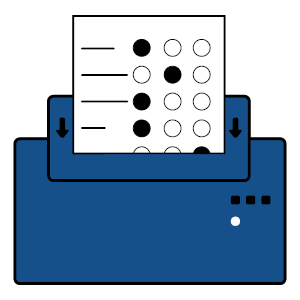Form Design Best Practices
The key to accurate recognition is a well designed form. Check out our tips below.
The key to accurate recognition is a well designed form. Check out our tips below.
Gravic’s Remark Office OMR is the world’s leading software for processing plain-paper OMR forms such as tests, assessments, surveys, evaluations, and more. The software allows you to create your own scannable forms using any word processor or design tool.
The key to getting great results with Remark Office OMR begins with a well-designed form. Although Remark Office OMR allows enormous flexibility in form design, adequate layout is crucial to recognizing data from scanned forms. By following a few simple guidelines below, you can expect great results!
Gravic Fonts: When possible, we recommend you use one of our OMR fonts on your forms. Gravic’s OMR fonts come in different styles including bubbles, rectangles, and squares. The fonts represent each of your answer choices in the desired shape with a letter or number printed inside. The fonts are specially designed for use with Remark Office OMR and are true-type fonts that can be used in most any Windows design application or word processor. If you do not want a letter or number inside your bubbles you can create an empty bubble by selecting the (`) key (the key to the left of the “1” on the U.S. Standard keyboard). These fonts install automatically with the Remark Office OMR software or can be downloaded here.


Other Fonts: If you are not using one of our OMR fonts, we recommend using a capital “O” in the Arial font. The Arial “O” provides an easy to fill in bubble and does not have some of the styling of other fonts. For instance, Times New Roman is a popular font but does not produce well designed bubbles for use with Remark.

Arial Font – Capital “O” Character 10-14 Point
Font Size: For best results we recommend your bubbles be between 10 and 14 points in height. You do not want to use anything smaller than 10 and larger bubbles are more difficult to fill in properly. The extra size just slows down the recognition process.
Font Shape: Although Remark Office OMR works with almost any complete shape (e.g. circle, square, triangle), non-oval shapes are somewhat harder to fill completely. Respondents typically fill bubbles more completely and neatly, which leads to better recognition rates. Generally, give young people more room both in the size of the marks and in the spacing between the marks since they typically lack the coordination of adults. Experiment with your target group where practical.
A very important consideration when designing a form is allowing proper spacing around and between your marks (bubbles).
A good rule of thumb is to allow at least 3/8 inch between any text, lines, or graphics on the form and any bubble areas, OCR/ICR text, or barcodes.
Minimize potential errors by separating your bubbles from one another by at least two character spaces.
In the example to the right you can see the space to the left and right of the first mark area denoted by arrow #1 and #2. The space above and below, denoted by arrows #3 and #4, is sufficiently spaced from any neighboring text or lines on the form. Arrow #5 shows the space between the columns of bubbles is correct. Bubbles cannot touch and need to be independent shapes as illustrated here.
We highly recommend not using lines or boxes around or between the bubbles on the form.
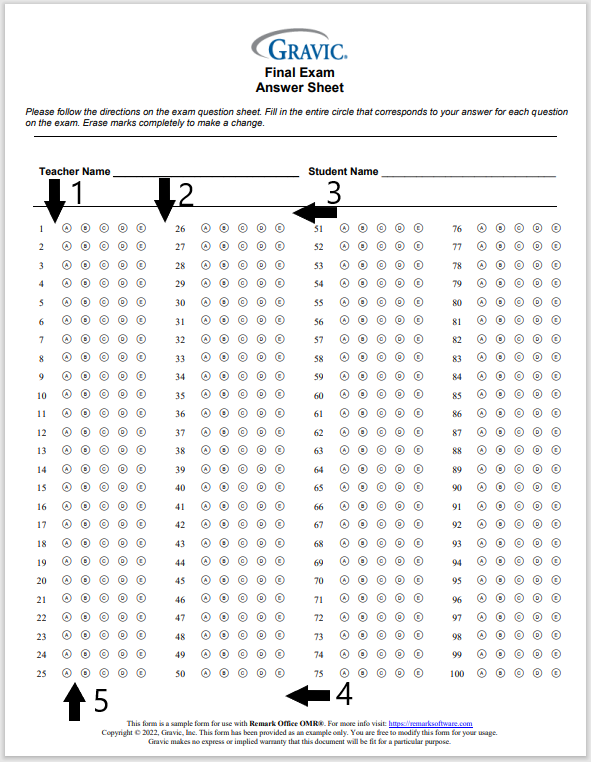
Remark Office OMR works best with bubbles printed in black ink without shading or lines of any kind in your OMR data areas.
If you feel you have to use shading to guide the user’s eye to the row of bubbles, you can use a light gray color shading. You will need to test this with your scanner to make sure when you scan the forms, the shading completely drops out (a 5-10% gray typically works best). Note that you cannot photocopy forms that use shading as the shading will add speckles to the image that can interfere with the recognition.
Similarly, if you have to use lines, make sure they are far enough from any OMR bubbles so you can set up the template correctly and not have the line interfere with recognition. If pages are scanned with any skew, lines will often be problematic. If you have to use a line, print the line in a light gray color so it will drop out when scanned.
Another way handle shading is to place it within the question area but stop short of the bubble area. The picture below illustrates this technique. This is the preferred method instead of shading within the mark area.
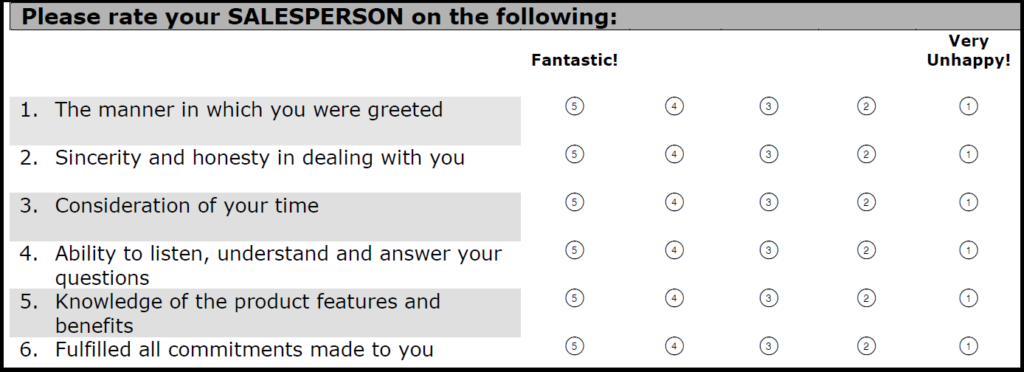
As always, test your form with your scanner before printing large quantities. Use clean printouts for forms utilizing shading.
When creating a form for scanning with Remark Office OMR there are two things to consider. First is make the form as scannable as possible. Second, make the job of setting up a Remark template as easy as possible. A well-designed form takes both of these items into consideration.
Remark Office OMR works best when you have more bubbles in a region. Being able to set up one region in your template to encompass all the bubbles of that region is always a good practice.
Below are two ways to represent the same question. On the left we have bubbles with the labels between each option. This is not a good way to represent this question on a scannable form. It will work to some degree, but you are more likely to experience recognition issues on poorly scanned forms. On the right the same question is displayed where the marks are in a column to the left of the text. This is easier to set up in the template and is less likely to be affected by poorly scanned forms.

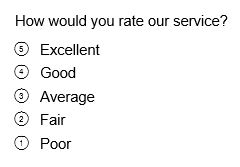
Similarly, grouping like questions together to create a larger region of bubbles will both simplify the template set up process and likely produce faster and better recognition results. When possible, organize your form so that similar types of questions are grouped together. In the example below you can see that the three rating questions were grouped in one region. All marks for a single field must align horizontally and vertically in this type of setup. A good way to do this in MS Word is to use a table for these types of questions.

Remark Office OMR works best with plain white paper and black ink. Utilizing standard 20# copier paper works well for single sided forms and 24-28# paper works well for double sided forms. We recommend white paper but you can use colored paper as long as the color completely drops out when scanned. A light pastel color such as yellow or cream tends to work well. Test your paper selection with your form and scanner before printing large quantities.
Remark Office OMR supports any paper size or thickness supported by your scanner. Consult your scanner’s user’s guide for further information on the sizes and thicknesses of paper it can feed.
You can print forms on a laser printer or multi-function printer/copier. Use the same device for all of the forms.
You can photocopy forms. The accuracy of page placement into the photocopier when copying forms and into the scanner when reading forms are the limiting factors as to how large your margins must be in order to minimize errors. Forms with inadequate spacing will have a low tolerance for offset/skew. Test your form before printing large quantities.
Try to photocopy as many forms as you need up front so that you do not end having to do your copying in different batches at different times. The alignment of the copier and the amount of toner will be more consistent if copied at the same time. Variability in these items can cause issues with recognition.
Print some extra forms and keep some unfilled forms on hand from your original batch. This way if you run out or if some get spoiled, you will always have a few extras.
Note: If making photocopies, create your template on the photocopied version rather than the original.
You can use barcodes on your forms in one of several 1D and 2D supported formats. They can be placed horizontally or vertically on the form.
Barcodes should be at least 26 points in height.
A free barcode font, Code 3 of 9, installs with the software and can also be downloaded here. When using this font in a word processor you type the text you want to represent in the barcode in a human readable font. Then you select the text and change the font to the 3 of 9 Barcode font. When using the 3 of 9 Barcode font the data in the barcode must start and end with an asterisk character as in the example below.

Similar to OMR bubbles, leave at least 3/8 inch of space around your barcode. Do not bold or italicize barcodes. Remember that barcodes may vary in length depending on what you are capturing. Leave room for the largest expected barcode both on the form and when you create your region definition in your Remark template.
If you plan to use our OCR (Optical Character Recognition) feature to read preprinted text on a form, use a larger font size, such as 14 or larger. When selecting a font, use a common font such as Arial or Times New Roman. Stay away from handwriting style fonts, which are harder to interpret. If you notice letters that almost touch each other due to their shape, use your word processor’s character spacing feature (sometimes called kerning) to put more space between the letters. Do not bold or italicize OCR text. When it comes time to scan forms that use OCR, use a scanner resolution of 300 DPI (dots per inch).
Remark Office OMR allows you to use your Microsoft Azure Computer Vision account to perform ICR (Intelligent Character Recognition). ICR allows you to automatically read handwriting on the form, such as comments and short answer questions. It is very important to note that Remark does not have its own ICR component. It allows you to use your Microsoft Azure Computer Vision account within Remark to capture handwriting on your forms. Thus, the quality of the recognition is solely reliant on the Microsoft ICR engine. If you have any issues recognizing handwriting, please consult Microsoft. Microsoft’s ICR tends to work better with unconstrained handwriting. When designing a form, it is important to have some amount of white space around the area where respondents will write. For example, leave some space between the question text and the handwriting area. Using boxes or lines to guide respondents where to write can also interfere with recognition of the handwriting. If the boxes or lines are light enough to drop out (disappear) during scanning, the results may be better (note that photocopying forms with light boxes or lines will likely cause them to become darker and not drop out). The instructions for obtaining a Microsoft Azure account with Computer Vision for ICR can be found here.
We have created some common form elements for you to download and use in your forms, including: Numeric ID bubble-fields (3, 4, 5, and 6 digits), bubble-in name grid, month-to-minute timecard, and several images showing how to properly fill in bubbles.

We have created a variety of sample forms for Remark Office OMR. The files include Word and PDF versions of the forms, an OMR template file, and some filled-in image files for demo purposes. You can use any of these Word documents as a starting point for your form and modify them as necessary. You can also modify the template files as needed. Remember to always test your form and template prior to distribution. You can also take advantage of our free form review service.

Think you are finished designing your form? Not so fast! We strongly recommend you have a Remark Expert review your form before you print and distribute it! We offer a FREE service to all Remark customers and those using trial versions. A Remark Expert will take a look at your form and provide feedback to you on your design. It is FREE and painless, and will potentially save you a lot of work down the road. Click the link to learn more about this FREE service.
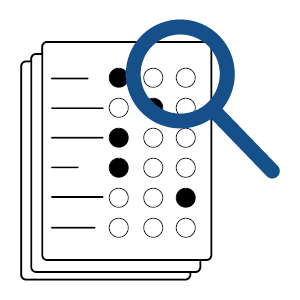
Always test any forms you plan to use with Remark Office OMR before printing and distributing them. Fill out several copies just like your respondents will… not perfectly! Then scan them to ensure you have a good form design and have set up your Remark template correctly.
